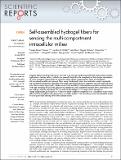Self-assembled hydrogel fibers for sensing the multi-compartment intracellular milieu
Author(s)
Vemula, Praveen Kumar; Kohler, Jonathan E.; Blass, Amy; Williams, Miguel; Xu, Chenjie; Chen, Lynna; Jadhav, Swapnil R.; John, George; Soybel, David I.; Karp, Jeffrey Michael; ... Show more Show less
DownloadVemula-2014-Self-assembled hydrogel.pdf (1.303Mb)
PUBLISHER_CC
Publisher with Creative Commons License
Creative Commons Attribution
Terms of use
Metadata
Show full item recordAbstract
Targeted delivery of drugs and sensors into cells is an attractive technology with both medical and scientific applications. Existing delivery vehicles are generally limited by the complexity of their design, dependence on active transport, and inability to function within cellular compartments. Here, we developed self-assembled nanofibrous hydrogel fibers using a biologically inert, low-molecular-weight amphiphile. Self-assembled nanofibrous hydrogels offer unique physical/mechanical properties and can easily be loaded with a diverse range of payloads. Unlike commercially available E. coli membrane particles covalently bound to the pH reporting dye pHrodo, pHrodo encapsulated in self-assembled hydrogel-fibers internalizes into macrophages at both physiologic (37°C) and sub-physiologic (4°C) temperatures through an energy-independent, passive process. Unlike dye alone or pHrodo complexed to E. coli, pHrodo-SAFs report pH in both the cytoplasm and phagosomes, as well the nucleus. This new class of materials should be useful for next-generation sensing of the intracellular milieu.
Date issued
2014-03Department
Harvard University--MIT Division of Health Sciences and Technology; Massachusetts Institute of Technology. Department of Biological EngineeringJournal
Scientific Reports
Publisher
Nature Publishing Group
Citation
Vemula, Praveen Kumar, Jonathan E. Kohler, Amy Blass, Miguel Williams, Chenjie Xu, Lynna Chen, Swapnil R. Jadhav, George John, David I. Soybel, and Jeffrey M. Karp. “Self-Assembled Hydrogel Fibers for Sensing the Multi-Compartment Intracellular Milieu.” Sci. Rep. 4 (March 26, 2014).
Version: Final published version
ISSN
2045-2322